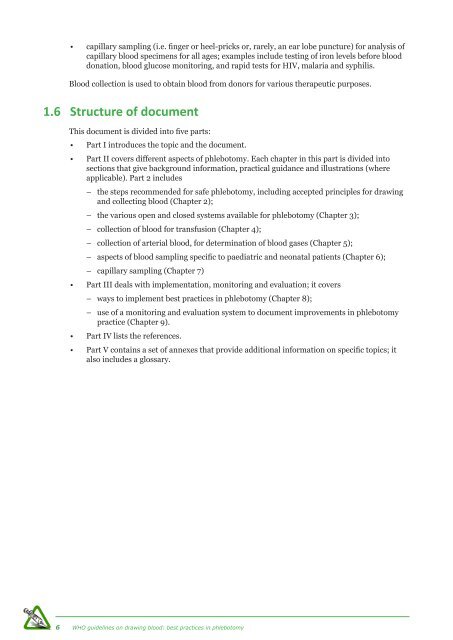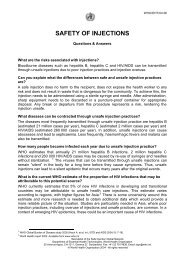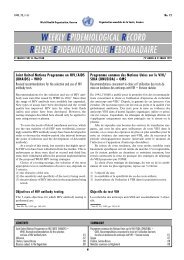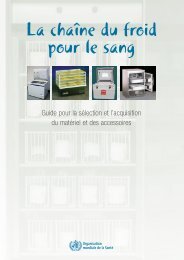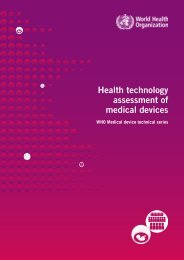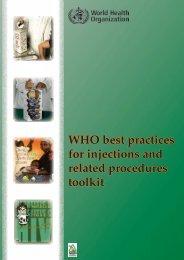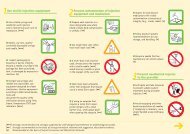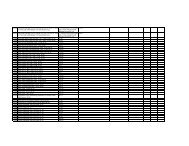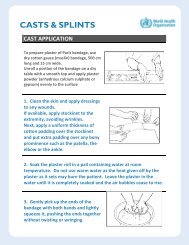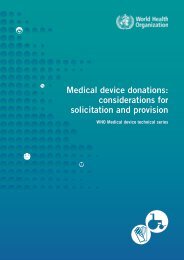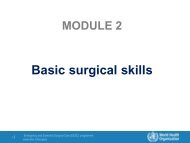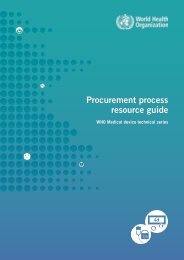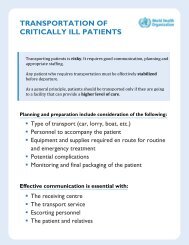WHO Guidelines on Drawing Blood: Best Practices in Phlebotomy
WHO Guidelines on Drawing Blood: Best Practices in Phlebotomy
WHO Guidelines on Drawing Blood: Best Practices in Phlebotomy
- No tags were found...
Create successful ePaper yourself
Turn your PDF publications into a flip-book with our unique Google optimized e-Paper software.
• capillary sampl<strong>in</strong>g (i.e. f<strong>in</strong>ger or heel-pricks or, rarely, an ear lobe puncture) for analysis of<br />
capillary blood specimens for all ages; examples <strong>in</strong>clude test<strong>in</strong>g of ir<strong>on</strong> levels before blood<br />
d<strong>on</strong>ati<strong>on</strong>, blood glucose m<strong>on</strong>itor<strong>in</strong>g, and rapid tests for HIV, malaria and syphilis.<br />
<strong>Blood</strong> collecti<strong>on</strong> is used to obta<strong>in</strong> blood from d<strong>on</strong>ors for various therapeutic purposes.<br />
1.6 Structure of document<br />
This document is divided <strong>in</strong>to five parts:<br />
• Part I <strong>in</strong>troduces the topic and the document.<br />
• Part II covers different aspects of phlebotomy. Each chapter <strong>in</strong> this part is divided <strong>in</strong>to<br />
secti<strong>on</strong>s that give background <strong>in</strong>formati<strong>on</strong>, practical guidance and illustrati<strong>on</strong>s (where<br />
applicable). Part 2 <strong>in</strong>cludes<br />
––<br />
the steps recommended for safe phlebotomy, <strong>in</strong>clud<strong>in</strong>g accepted pr<strong>in</strong>ciples for draw<strong>in</strong>g<br />
and collect<strong>in</strong>g blood (Chapter 2);<br />
––<br />
the various open and closed systems available for phlebotomy (Chapter 3);<br />
––<br />
collecti<strong>on</strong> of blood for transfusi<strong>on</strong> (Chapter 4);<br />
––<br />
collecti<strong>on</strong> of arterial blood, for determ<strong>in</strong>ati<strong>on</strong> of blood gases (Chapter 5);<br />
––<br />
aspects of blood sampl<strong>in</strong>g specific to paediatric and ne<strong>on</strong>atal patients (Chapter 6);<br />
––<br />
capillary sampl<strong>in</strong>g (Chapter 7)<br />
• Part III deals with implementati<strong>on</strong>, m<strong>on</strong>itor<strong>in</strong>g and evaluati<strong>on</strong>; it covers<br />
––<br />
ways to implement best practices <strong>in</strong> phlebotomy (Chapter 8);<br />
––<br />
use of a m<strong>on</strong>itor<strong>in</strong>g and evaluati<strong>on</strong> system to document improvements <strong>in</strong> phlebotomy<br />
practice (Chapter 9).<br />
• Part IV lists the references.<br />
• Part V c<strong>on</strong>ta<strong>in</strong>s a set of annexes that provide additi<strong>on</strong>al <strong>in</strong>formati<strong>on</strong> <strong>on</strong> specific topics; it<br />
also <strong>in</strong>cludes a glossary.<br />
6 <str<strong>on</strong>g>WHO</str<strong>on</strong>g> guidel<strong>in</strong>es <strong>on</strong> draw<strong>in</strong>g blood: best practices <strong>in</strong> phlebotomy


